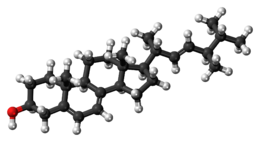エルゴステロール
Ergosterol/ja

| |

| |
| Names | |
|---|---|
| IUPAC name
(22E)-Ergosta-5,7,22-trien-3β-ol
| |
| Systematic IUPAC name
(1R,3aR,7S,9aR,9bS,11aR)-1-[(2R,3E,5R)-5,6-Dimethylhept-3-en-2-yl]-7-hydroxy-9a,11a-dimethyl-2,3,3a,6,7,8,9,9a,9b,10,11,11a-dodecahydro-1H-cyclopenta[a]phenanthren-7-ol | |
| Identifiers | |
3D model (JSmol)
|
|
| ChEBI | |
| ChEMBL | |
| ChemSpider | |
| EC Number |
|
| MeSH | Ergosterol |
PubChem CID
|
|
| UNII | |
| |
| |
| Properties | |
| C28H44O | |
| Molar mass | 396.65 g/mol |
| Melting point | 160 °C (320 °F; 433 K) |
| Boiling point | 250 °C (482 °F; 523 K) |
| -279.6·10−6 cm3/mol | |
エルゴステロール(ergosta-5,7,22-trien-3β-ol)は、菌類や原生動物の細胞膜に存在するマイコステロールの一種で、コレステロールが動物細胞で果たすのと同じ機能の多くを果たす。多くの菌類や原生動物はエルゴステロールなしでは生存できないため、エルゴステロールを合成する酵素は創薬の重要な標的となっている。ヒトの栄養学において、エルゴステロールはビタミンD2のプロビタミン形態であり、紫外線(UV)にさらされると化学反応を起こしてビタミンD2を生成する。
Role in fungi
Ergosterol (ergosta-5,7,22-trien-3β-ol) is a sterol found in fungi, and named after ergot, the common name of members of the fungal genus Claviceps from which ergosterol was first isolated. Ergosterol is a component of yeast and other fungal cell membranes, serving many of the same functions that cholesterol serves in animal cells. Its specificity in higher fungi is thought to be related to the climatic instabilities (highly varying humidity and moisture conditions) encountered by these organisms in their typical ecological niches (plant and animal surfaces, soil). Thus, despite the added energy requirements of ergosterol synthesis (if compared to cholesterol), ergosterol is thought to have evolved as a nearly ubiquitous, evolutionarily advantageous fungal alternative to cholesterol. This advantage could be linked to the presence of two conjugated double bonds in the structure (B-ring) of ergosterol giving it antioxidant properties.
Target for antifungal drugs
Because ergosterol is present in cell membranes of fungi, yet absent in those of animals, it is a useful target for antifungal drugs. Ergosterol is also present in the cell membranes of some protists, such as trypanosomes. This is the basis for the use of some antifungals against West African sleeping sickness.
Amphotericin B, an antifungal drug, targets ergosterol. It binds physically to ergosterol within the membrane, thus creating a polar pore in fungal membranes. This causes ions (predominantly potassium and hydrons) and other molecules to leak out, which will kill the cell. Amphotericin B has been replaced by safer agents in most circumstances, but is still used, despite its side effects, for life-threatening fungal or protozoan infections.
フルコナゾール、ミコナゾール、イトラコナゾール、クロトリマゾール、ミクロブタニルは、14α-デメチラーゼを阻害することによって、ラノステロールからエルゴステロールの合成を阻害するという異なる方法で作用する。エルゴステロールはラノステロールよりも小さな分子であり、炭素長15個のテルペノイドであるピロリン酸ファルネシル2分子を炭素長30個のラノステロールに結合させることで合成される。その後、2つのメチル基が取り除かれ、エルゴステロールとなる。アゾール系抗真菌剤は、ラノステロールとエルゴステロールの間の生合成経路において、これらの脱メチル化工程を行う酵素を酵素阻害剤として阻害する。
抗原虫薬の標的
トリコモナスやリーシュマニアを含むいくつかの原虫は、エルゴステロールの合成と機能を標的とする薬物によって阻害される。
ビタミンD2前駆体として
エルゴステロールはビタミンD2の生物学的前駆体であり、その化学名はエルゴカルシフェロールである。ホワイトボタン・マッシュルームを30 cmの距離から0.403 mW/cm2の強度でUV-C照射すると、ビタミンD2濃度が時間依存的に増加した。
これはある程度自然に起こることであり、多くのキノコはビタミンD含有量を増やすために収穫後に放射線を照射される。また、エルゴステロールを抽出してビタミンDに変換し、栄養補助食品や食品添加物として販売するために、キノコは工業的に栽培されている。
プレビタミンとビタミンD2の混合物を含む照射エルゴステロールの製剤は、1930年代にはビオステロールと呼ばれていた。
毒性
エルゴステロール粉末は、皮膚、目、呼吸器官を刺激する。多量の摂取は高カルシウム血症を引き起こす可能性があり、(長引くと)軟部組織および腎臓にカルシウム塩が沈着する。
こちらも参照